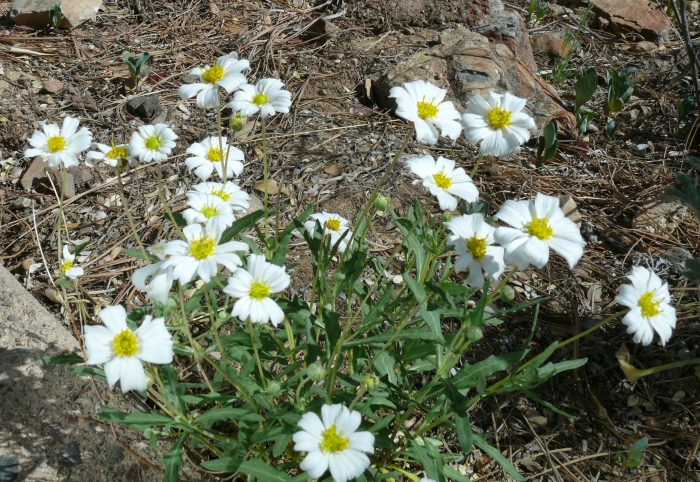Blackfoot Daisy
(Melampodium leucanthum)
Blackfoot Daisy (Melampodium leucanthum)
/
/

Sue in az
Public domain
Image By:
Sue in az
Recorded By:
Copyright:
Public domain
Copyright Notice:
Photo by: Sue in az | License Type: Public domain | License URL: https://creativecommons.org/public-domain/ | Uploader: Sue in az~commonswiki | Publisher: Wikimedia Commons | Title: Melampodium-leucanthum.jpg | Notes: [[Commons:Batch_uploading/AucklandMuseumCCBY|Auckland Museum]] Page 415.16 Object #41515 AK355765 Image 5/5 http://api.aucklandmuseum.com/id/media/v/348151 |



















































Estimated Native Range
Summary
Melampodium leucanthum, commonly known as Blackfoot Daisy, is a herbaceous perennial native to arid grasslands, rocky plains, and desert scrub areas in the southwestern United States and northern Mexico, particularly within the Chihuahuan and Sonoran Deserts. It typically forms a low mound about 6-12 inches (15-30 cm) in height and spreads 12-24 inches (30-60 cm) wide. The plant is characterized by its narrow, linear leaves and abundant, daisy-like white flowers with yellow centers that bloom profusely from early spring to late fall, providing a long season of visual interest. The flowers are highly attractive to pollinators and are quite showy against the plant’s silvery-green foliage.
Blackfoot Daisy is valued for its drought tolerance, heat resistance, and ability to thrive in poor, rocky soils, making it an excellent choice for xeriscaping and rock gardens. It is also used in borders, as a ground cover, and in container plantings. This plant requires minimal maintenance, is not typically bothered by pests or diseases, and is deer resistant. It is essential to avoid overwatering, as it can lead to root rot. Blackfoot Daisy prefers full sun but can tolerate part shade, and it requires well-drained soil to prevent moisture-related problems.CC BY-SA 4.0
Blackfoot Daisy is valued for its drought tolerance, heat resistance, and ability to thrive in poor, rocky soils, making it an excellent choice for xeriscaping and rock gardens. It is also used in borders, as a ground cover, and in container plantings. This plant requires minimal maintenance, is not typically bothered by pests or diseases, and is deer resistant. It is essential to avoid overwatering, as it can lead to root rot. Blackfoot Daisy prefers full sun but can tolerate part shade, and it requires well-drained soil to prevent moisture-related problems.CC BY-SA 4.0
Plant Description
- Plant Type: Subshrub, Herb
- Height: 0.5-1 feet
- Width: 1-2 feet
- Growth Rate: Moderate
- Flower Color: White
- Flowering Season: Spring, Summer, Fall
- Leaf Retention: Evergreen
Growth Requirements
- Sun: Full Sun, Part Shade
- Water: Medium
- Drainage: Medium
Common Uses
Bank Stabilization, Bee Garden, Bird Garden, Border Plant, Butterfly Garden, Deer Resistant, Drought Tolerant, Fragrant, Groundcover, Low Maintenance, Potted Plant, Rock Garden, Showy Flowers
Natural Habitat
Native to arid grasslands, rocky plains, and desert scrub areas in the southwestern United States and northern Mexico
Other Names
Common Names: Plains Blackfoot Daisy
Scientific Names: , Melampodium leucanthum, Melampodium leucanthum var. leucanthum,
GBIF Accepted Name: Melampodium leucanthum Torr. & A.Gray